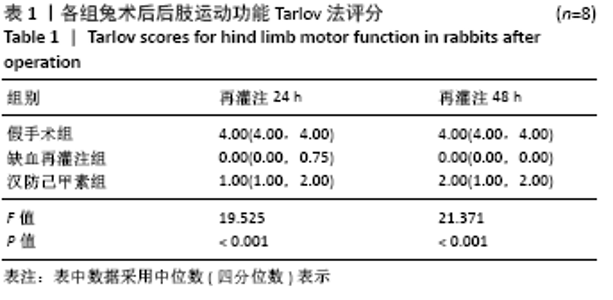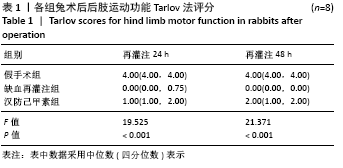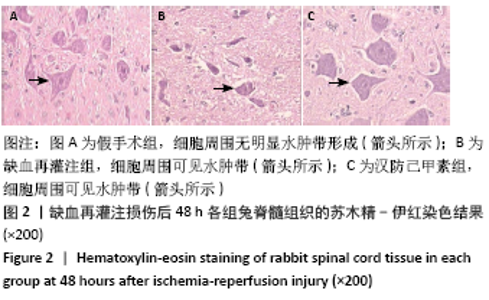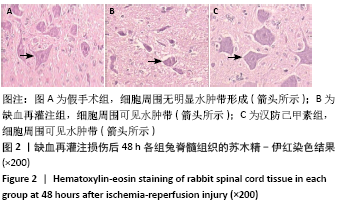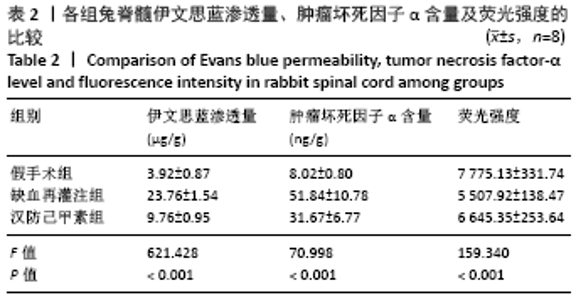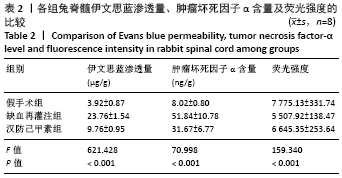[1] BECKER DA, MCGARVEY ML, ROJVIRAT C, et al. Predictors of outcome in patients with spinal cord ischemia after open aortic repair. Neurocrit Care. 2013;18(1):70-74.
[2] YU Q, HUANG J, HU J, et al. Advance in spinal cord ischemia reperfusion injury:Blood-spinal cord barrier and remote ischemic preconditioning. Life Sci. 2016;154:34-38.
[3] 夏炳江, 肖鲁伟. 脊髓慢性压迫减压后缺血再灌注损伤研究进展[J]. 中华中医药学刊,2017,35(4):998-1001.
[4] LUAN F, HE X, ZENG N. Tetrandrine: a review of its anticancer potentials, clinical settings, pharmacokinetics and drug delivery systems. J Pharm Pharmacol. 2020;72(11):1491-1512.
[5] ZHANG TJ, GUO RX, LI X, et al. Tetrandrine cardioprotection in ischemia-reperfusion (I/R) injury via JAK3/STAT3/Hexokinase II. Eur J Pharmacol. 2017;813:153-160.
[6] BAO G, LI C, QI L, et al. Tetrandrine protects against oxygen-glucose-serum deprivation/reoxygenation-induced injury via PI3K/AKT/NF-kB signaling pathway in rat spinal cord astrocytes. Biomed Pharmacother. 2016;(84):925-930.
[7] 罗春山,田晓滨,汪雷,等.汉防己甲素对大鼠急性脊髓损伤后bcl-2和bax表达的影响[J].第三军医大学学报,2010,32(12):1321-1324.
[8] 王雨榕,邓强,郭铁峰,等.缺血再灌注脊髓损伤动物造模研究进展[J]. 中国实验动物学报, 2019, 27(5):658-662.
[9] 刘碧波,刘淼,马巍,等.脊髓缺血再灌注损伤时间窗及其行为学的实验研究[J]. 陕西医学杂志,2004,33(12):1080-1082.
[10] 罗春山. 汉防己甲素对大鼠急性脊髓损伤后神经保护作用的机制研究[D].重庆:重庆医科大学,2013.
[11] 张沛,刘斌,任伟,等.脊髓缺血再灌注损伤[A]. 北京:中国康复医学会颈椎病专业委员会学术年会,2010:221-222.
[12] 丁倩.七氟烷预处理对兔脊髓缺血/再灌注损伤保护作用的研究[D].西安:第四军医大学,2009.
[13] 刘世琼, 董娜, 梅晰凡, 等. 外源性和内源性凋亡通路在骨髓间充质干细胞移植修复大鼠脊髓损伤中的作用[J]. 中华创伤杂志,2020, 36(11):1030-1037.
[14] 刘麟文,姚俊岩.神经系统缺血再灌注损伤保护措施的研究进展[J].医学综述,2020,26(4):105-110.
[15] 席苑,张海静,叶祖光,等.汉防己甲素现代药理作用研究进展[J].中国中药杂志,2020,45(1):28-36.
[16] FANG B, LI X Q, BI B, et al. Dexmedetomidine attenuates blood spinal cord barrier disruption induced by spinal cord ischemia reperfusion injury in rats. Cell Physiol Biochem. 2015;36(1):373-383.
[17] BARTANUSZ V, JEZOVA D, ALAJAJIAN B, et al. The blood-spinal cord barrier:morphology and clinical implications. Ann Neurol. 2011;70(2): 194-206.
[18] REINHOLD AK, RITTNER HL. Barrier function inthe peripheral and central nervous system-a review. Pflugers Arch. 2017;469(1):123-134.
[19] KOEHN LM. ABC efflux transporters at blood-central nervous system barriers and their implications for treating spinal cord disorders. Neural Regen Res. 2020;15(7):1235-1242.
[20] HU J, YU Q, XIE L, et al. Targeting the blood-spinal cord barrier: A therapeutic approach to spinal cord protection against ischemia-reperfusion injury. Life Sci. 2016;158:1-6.
[21] 余正然, 王晓波, 龙厚清. 血-脊髓屏障修复在脊髓损伤治疗中作用的研究进展[J]. 中国脊柱脊髓杂志,2019,29(2):179-184.
[22] 王瑞珂.神经病理性疼痛中TNF-a诱生晚期炎性介质的机制研究[D].长沙:中南大学,2011.
[23] ZAKA M, ABBASI BH, DURDAGI S. Novel tumor necrosis factor-α (TNF-α) inhibitors from small molecule library screening for their therapeutic activity profiles against rheumatoid arthritis using target-driven approaches and binary QSAR models. J Biomol Struct Dyn. 2019;37(9):2464-2476.
[24] 陈向华,王和鸣,张俐,等.丹参酮对脊髓缺血再灌注损伤细胞因子TNF-α、IL-1β、IL-1Ra的影响[J].中国中医骨伤科杂志,2012, 20(4):1-3.
[25] 苏权,党晓谦,王坤正,等.大鼠脊髓缺血再灌注后早期脊髓内促炎因子及抗炎因子的表达[J].陕西医学杂志,2016,45(10):1285-1287.
[26] 李敏,杨孝,孙年怡,等.脊髓损伤中TNF-α诱导细胞凋亡和坏死性凋亡的研究进展[J].广东医学,2018,39(18):2841-2843.
[27] 王兆麒,林多茂,薛艳艳,等.线粒体膜通透性转换孔与心肌缺血-再灌注损伤的研究进展[J].临床麻醉学杂志,2015,31(11):1134-1136.
[28] RAO VK, CARLSON EA, YAN SS. Mitochondrial permeability transition pore is a potential drug target for neurodegeneration. Mol Basis Dis. 2014;1842(8):1267-1272.
[29] KAUR D, YANTIRI F, RAJAGOPALAN S, et al. Genetic or pharmacological iron chelation prevents MPTP-induced neurotoxicity in vivo: a novel therapy for Parkinson’s disease. Neuron. 2003;37(6):899-909.
[30] SAMANTARAY S, KNARYAN VH, SHIELDS DC, et al. Inhibition of Calpain Activation Protects MPTP-Induced Nigral and Spinal Cord Neurodegeneration, Reduces Inflammation, and Improves Gait Dynamics in Mice. Mol Neurobiol. 2015;52(2):1054-1066.
[31] CHEN X, CUI J, ZHAI X, et al. Inhalation of Hydrogen of Different Concentrations Ameliorates Spinal Cord Injury in Mice by Protecting Spinal Cord Neurons from Apoptosis, Oxidative Injury and Mitochondrial Structure Damages. Cell Physiol Biochem. 2018;47(1):176-190. |
